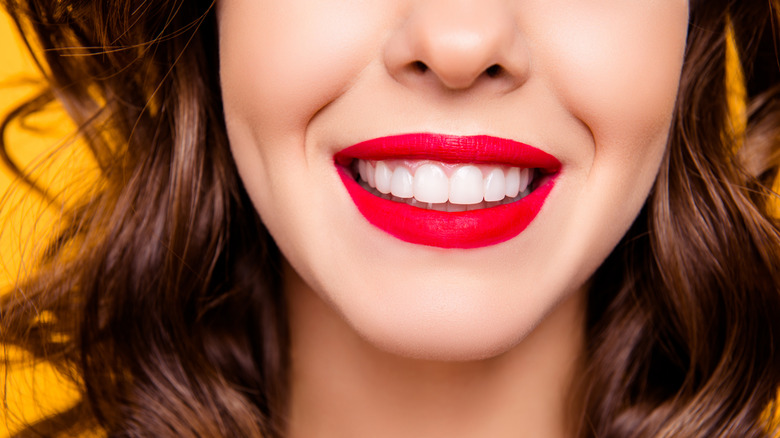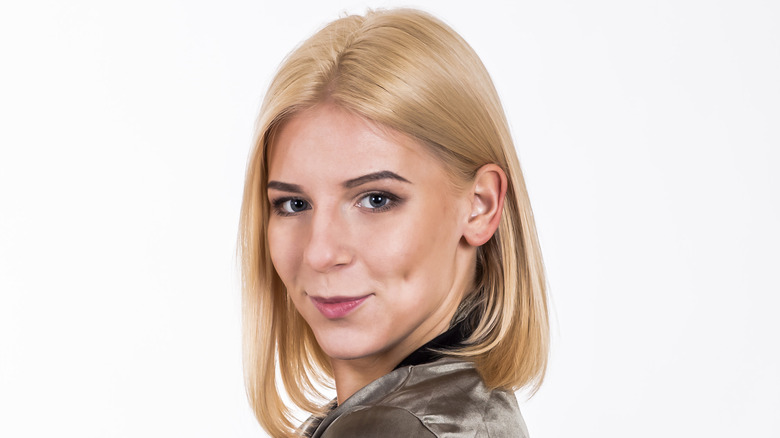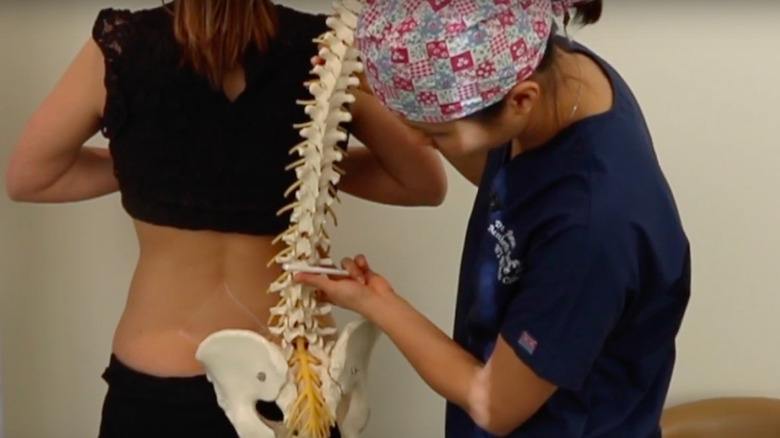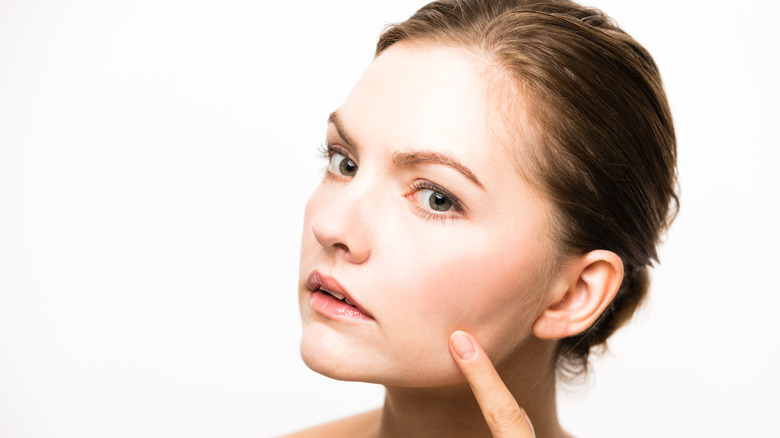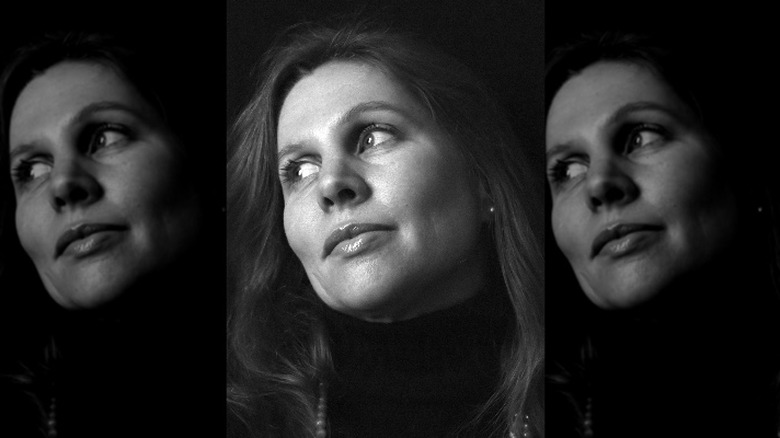The Truth About Dimples
Dimples — they're what stars Brad Pitt, Adam Levine, and Bradley Cooper all have in common. Well, having dimples and earning the title of People's Sexiest Man Alive at least once in their lifetimes. In fact, if you were to peruse all of People's Sexiest Man Alive covers — starting all the way back in the mid-1980s — you would notice a major trend. As it turns out, quite a few of the popular magazine's past winners have a set of indentations in their cheeks.
As much as you may love ogling dimpled dudes, this feature isn't just a guy thing. Women — including some of your favorite female celebs — also have the adorable depressions. You may not have even realized, but pop star Ariana Grande, singer Cheryl Cole, actress Cameron Diaz, and even the Duchess of Cambridge, Kate Middleton, have them. But what even are dimples anyway? Here's the truth about these incredibly unique indentations.
The gelasin joyous
You don't have to have dimples to know what they are. Yet and still, even those with dimples would probably be confused if someone complimented their "gelasin." Although the word sounds remarkably like "gelatin," it has a vastly different meaning than the water-soluble protein. As wordsmith.org revealed, gelasin is actually just another term for dimples. It comes from the Greek word "gelaein" which means "to laugh." Martial, a first-century Roman poet may have been one of the first to write about dimples, calling one without "the gelasin joyous" a "face less gracious" (via Treatise on Laughter).
By the 21st century, however, "dimples" had largely won out as the more popular term. Still, medical journals often use the terms interchangeably. Of course, you can now impress — or irritate — your friends by labeling everyone's dimples as gelasin. You're welcome for that, by the way. Regardless of what you choose to call them, a 2016 report in the Journal of Pharmaceutical Science and Research defines gelasin and dimples as "small folds or indentations in the fleshy part of the cheek."
A genetic abnormality
It may be hard to believe, but dimples are actually a birth defect. In an interview with Smithsonian Magazine, Brent Moelleken, a plastic surgeon and associate clinical professor of surgery at the University of California in Los Angeles, explained, "Cheek dimples are a genetically transmitted abnormality of a muscle in the cheek." Unlike many other genetic birth defects — like sickle cell disease and anemia — cheek dimples are no cause for alarm.
People with dimples have what's called a "bifid zygomaticus major muscle." Don't worry, there won't be a quiz at the end. Basically, this muscle abnormally divides into two sections and attaches to the cheek. "This fibrous connection causes a dimple to become deeper and more visible when a person smiles, flexing that muscle," Anthony Youn, a plastic surgeon in Troy, Mich. revealed to Smithsonian. While there is a muscular difference between those with dimples and those without, dimples are pretty much a non-factor when it comes to a person's health.
They're not always inherited
Despite being a genetic abnormality, dimples aren't always passed down from parents to their children. According to University of Utah's Genetic Science Learning Center, Learn.Genetics, dimples are considered "highly heritable." To understand the concept of what's "highly heritable," you don't have to look much further than the Ben Affleck and Jennifer Garner clan.
Both Garner and ex-husband Affleck have dimples. And each and every one of the pair's three children — Violet, Seraphina, and Samuel — also have dimples. However, had the parents went on to have a fourth and fifth child, those children would not necessarily inherit dimples. "Because their inheritance isn't completely predictable, dimples are considered an 'irregular' dominant trait," the university explained. "Having dimples is probably controlled mainly by one gene but also influenced by other genes."
So, if you come from a family of dimples and don't have them yourself, the reason is because they are only mostly heritable. It's also entirely possible to have dimples yourself while your parents do not. According to a 2017 study, "a spontaneous mutation" explains why some children end up with dimples while their parents remain dimple-less. Science is strange, folks.
Not too many Americans have dimples
The DNA genetic testing and analysis site 23andMe.com, revealed that their studies have shown "at least nine different genetic variants contribute to dimpling." Because of dimples' "highly heritable" nature, you might think them to be incredibly common. While it's true that dimples are way more prevalent than many other birth defects that are considered "common," you're more likely not to have dimples. In fact, around 80 percent of the United States population does not have the facial abnormality. As the Infinity Medical Group revealed in an article on their site, researchers have estimated that roughly 20 percent of the American population has dimples.
Nevertheless, dimples are, of course, not confined to nationality. Smithsonian Magazine highlighted that people of "all races and ethnicities" can have dimples. Studies have been conducted on the facial indentations as far as India and Turkey, but, as of this writing, no worldwide statistics have been released. In fact, there's probably a lot more to learn about dimples in general. A 2017 study revealed that only a "limited" amount of research has been conducted on "the anatomy of dimples."
A symbol of good luck
In the United States, those without dimples may refer to those with a gelasin grin as lucky. We all want what we can't have, right? As it happens, though, dimples are literally considered a symbol of good luck in other parts of the world. In China, for example, dimples have long been associated with everything from good will to attractiveness. "And it has come to be accepted that a dimpled wife is one who brings happiness and good luck to the family," a 1962 Plastic and Reconstructive Surgery article read.
Since the midcentury, other Asian countries have also started associating dimples with "a beautiful smiling face," the Department of Plastic Surgery Hospital at the Chinese Academy of Medical Sciences and Peking Union Medical College in Beijing, China revealed. In the 2007 study, researchers revealed that "the dimple can make [Asian women] more confident." Naturally, this poses a challenge for women who do not possess the genetic abnormality.
Chin dimples differ from cheek dimples
Not everyone who has facial dimples has them on their cheeks. Some people have what's called cleft chins. Unlike your garden variety chin, cleft chins have a small gap or dimple through the middle. Like cheek dimples, whether or not you have a cleft chin depends on your genetics. If one of your parents has a cleft chin, you have a greater chance of having one too. Although there are definitely similarities between chin and cheek dimples, there are also some pretty big differences.
Dimpled cheeks are the result of a muscular abnormality whereas a chin dimple is actually the result of the malformation of the lower jaw. During typical fetal development, the lower jaw fuses together. A cleft chin results when the jaw does not fully fuse. It may sound a little scary, but — just like cheek dimples — there are no adverse effects. Chin and cheek dimples can exist together as well as separately, and both types of dimples become more apparent when smiling.
The rarest dimple of them all
Dimples, it would seem, play by their own rules. A report by professors at the Department of Anatomy at Abant Izzet Baysal University in Turkey revealed that "dimples frequently take place on both" sides of a person's face. The keyword being frequently. In what researchers called "a rare phenomenon," it's possible that a person can possess a unilateral dimple: just one lone dimple on either the left or right side of his or her face.
Even rarer than this sort of dimple, though, is the "fovea inferior angle oris" — aka one dimple on each side of the mouth corners. If you happen to have this unicorn dimple, you should know you're very unique. In fact, you're so unique that science hasn't even caught up with you yet. In their 2017 case report, the researchers in Turkey noted that there haven't been any studies demonstrating "the frequency of this different kind [of] dimple." But, from the one case the researchers were able to evaluate, these mouth corner dimples do appear to be genetic. The 20-year-old volunteer who participated in the study also had a grandmother with dimples in the same location.
All about those body dimples
Even with all of the different kinds of facial dimples a person can have, dimples are not just confined to the cheeks or chin or even mouth corners. They can actually occur in numerous areas of the body. Some people have two indentations on their lower backs. These bilateral back dimples — dubbed "dimples of Venus" — are caused by "a short ligament stretching between the posterior superior iliac spine and the skin," according to a 2014 article in the International Journal of Dermatology. Just like chin, cheek, and mouth corner dimples, lower back dimples are assumed to be genetic.
Although all dimples are technically abnormal, the above varieties are all benign. That is, they're not going to cause you any harm. Dimpling of the skin in other areas of the body, however, can be cause for concern. According to the dermatological report, unusual dimples in the skin "may be the first sign of a significant development defect or abnormality." Sometimes, these dimples can be a sign of infection or other serious medical conditions. If you happen to develop dimples out of nowhere, it's best to consult your doctor.
The V-spot treatment
Those without the genetic disposition for dimples of Venus have actually been able to go under the knife and have them added. Harper's Bazaar theorized that these back indentations — and the effort some have taken to get them — have become more and more popular in recent years because, thanks to social media, we now know which celebrities — ahem, Kendall Jenner — have back dimples.
In 2017, plastic surgeon Amanda Wong-Powell, the founder and medical director of W1 Wellness Clinic in London, England, came up with her very own procedure known as "the V-Spot" treatment. In an interview with Harper's Bazaar, she revealed, "Throughout the decades, it has been known that 'Venus dimples' are sexy. Enhancing that spot and sculpting it further enhances this. It is a symbol of wellness, youthfulness and sexiness."
The plastic surgeon's technique first involves liposuction. After removing fat from two spots on the lower back — where the bilateral dimples would naturally occur — the area is then sculpted to realistically mimic dimples of Venus. However, these faux dimples don't come cheap. In early 2017, the procedure began retailing at £4,900 (about $6,400). Yikes.
Cheek dimples are an appealing feature
People from all backgrounds love dimples, but the science isn't exactly crystal clear on why this is. Plastic surgeon Amanda Wong-Powell speculates that lower back dimples are attractive because they signify fitness and youth. But is that the case with cheek dimples, too? Brent Moelleken, plastic surgeon and associate clinical professor of surgery at the University of California in Los Angeles, told Smithsonian Magazine: "People debate why this is an appealing feature." It could be, he theorized, that dimples are a sort of "feature of youth." Because babies have "so much fat in their cheeks," they often have dimples, albeit temporary ones, the plastic surgeon explained.
Could it really be that simple? Do we all just view people with cheek dimples as baby-faced and youthful? Well, as youthful faces are often considered to be more attractive, it really wouldn't be that far-fetched to think dimples are attractive solely because they add to that sprightly look.
Hence, the dimple multitool
Whatever the reason, dimples have been attractive for a very long time. And, perhaps nearly as long, people without dimples have been looking for ways to get the attractive indentations. "Any woman who has been overlooked by nature in the distribution of dimples can have the deficiency supplied by machinery," read a 1896 edition of the New York Herald (via International Journal of Dermatology). Um, what's that now? "Of course, the machinery must be in the hands of a skilled manipulator, or the result would be an unsightly scar, or possibly an open sore or complications of blood-poisoning." Well, of course. But, you know, you could have dimples!
As if the side effects weren't horrifying enough, the truly bizarre 19th century procedure involved a "specially-designed knife" complete with a "dainty, but very sharp, blade, a tiny, keen-edged scoop, and a very fine needle." The all-in-one-tool would first be used to cut the skin on a woman's cheeks, scoop out "the fat" in the shape of dimples, and then stitch the cheeks closed with the needle. Hard pass.
Don't forget the dimple machine
By the 1900s, dimples were obviously still in demand. "Dimples are now made to order!" a newspaper published in 1936 (via The Atlantic) revealed. We do have to give props to Isabella Gilbert of Rochester, N.Y., the inventor of the contraption, for coming up with a non-surgical "dimple machine," but, um, it was still pretty horrifying.
"The device consists of a face-fitting spring carrying two tiny knobs which press into the cheeks." The advertisement promised "a fine set of dimples." One can only imagine the discomfort of pressing things into their cheeks all hours of the day or night. You also have to imagine how this would've actually worked. As the wire that holds the knobs also fits tightly around the sides of the face and chin, it had to cause some unintended impressions, right? The ad may have labeled the machines "aids to beauty," but we'll just say we have our doubts.
Dimpleplasty: it's a thing
As terrifying as some of the older dimple inventions may have been, procedures to create facial dimples still exist. According to Healthline, people who weren't born with dimples can opt to have an outpatient procedure fittingly called a dimpleplasty.
After applying an anesthetic, a plastic surgeon uses "a small biopsy instrument" to remove muscle and fat where the "dimples" will be. A suture is then positioned to "set" the dimple in its place. It is not generally considered a risky procedure, but it is one that is challenging to reverse. Additionally, time may not be kind to cosmetically-enhanced dimples.
"As the skin ages and loses elasticity, there is no telling how the scars will look as the face begins to droop — designer dimples could become designer disasters within a matter of years," a spokesperson for SurgiCare plastic surgeons told Fox News. These so-called "designer dimples" also do not look nearly as realistic as, well, natural dimples. When a person with natural dimples is not smiling, you don't really see the impressions in their cheeks. However, the surgically-added dimples can be seen no matter the person's facial expression.
Dimples are (mostly) forever
Although the longevity of "designer dimples" is yet to be seen, natural dimples are pretty much forever. And, unfortunately for those who are less than pleased to have dimples, surgical removal is not a viable option. "I've had a number of patients ask me over the years if I could remove a dimple for them," Anthony Youn, a plastic surgeon in Troy, Mich., revealed to Smithsonian Magazine. "I tell them it's virtually impossible." As he noted to the magazine, "Even with a facelift, cheek dimples will not disappear."
However, dimples can appear to fade over time due to fat loss. And, as earlier mentioned, babies can experience dimpling of the skin from excess fat. Once the little one grows and loses fat, the dimples will cease to exist. Babies who were born with real deal dimples though — that is, cheek dimples caused by the genetic abnormality of the cheek muscles, a cleft chin from a jaw malformation, or dimples of Venus that result from a short ligament — will grow up into dimpled, and might we add attractive, adults.

